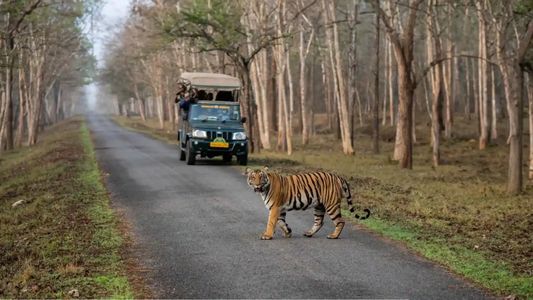Wild Wonders of Kabini: Exploring the Untamed Beauty of Its Animals and Ecosystem
 Palakshi Meharwal
14 May, 2025
11 mins read
29
Palakshi Meharwal
14 May, 2025
11 mins read
29

Nestled on the banks of the River Kabini in Karnataka, India, the Kabini Wildlife Sanctuary is a living tapestry of nature's finest works—where ancient forests, meandering backwaters, and open grasslands form a haven for some of the most iconic and elusive species in the Indian subcontinent. Part of the famed Nagarhole National Park and bordering the larger Nilgiri Biosphere Reserve, Kabini draws nature lovers, photographers, and researchers alike. But what makes this ecological gem so extraordinary isn’t just its beauty—it’s the vibrant interplay of flora, fauna, and ecological processes that sustain it.
Let’s journey into the heart of Kabini to explore the rich biodiversity, intricate ecosystems, and untamed wildlife that make this region one of India’s premier wilderness destinations.
A Mosaic of Ecosystems: Understanding Kabini's Natural Framework
Kabini’s landscape is a blend of tropical moist and dry deciduous forests interspersed with riverine habitats and grasslands. These diverse ecological zones are home to over 250 species of birds, more than 40 species of mammals, and countless reptiles and amphibians.
The deciduous trees—chiefly teak, rosewood, and sandalwood—shed leaves in the dry season, providing visibility and increased chances of spotting animals. Meanwhile, the Kabini River, fed by monsoon rains, supports a year-round water supply, which plays a crucial role in supporting large mammals during the dry months. This geographical confluence of water and forest makes Kabini an oasis for biodiversity.
Majestic Mammals: Spotlight on the Big Five of Kabini
Kabini is particularly renowned for its large mammals. Here are five key species that highlight the ecological importance of the region:
The Asian Elephant (Elephas maximus indicus)
One of the largest populations of wild elephants in South India can be found in Kabini. During summer, large herds—sometimes numbering over 50 individuals—gather along the banks of the river. These intelligent creatures shape the landscape by feeding on shrubs and saplings, effectively playing a role in forest regeneration.
The Bengal Tiger (Panthera tigris tigris)
Although elusive, Kabini offers one of the best chances to spot the Bengal tiger in its natural habitat. Tigers here are apex predators, maintaining the balance of herbivore populations and indicating the overall health of the ecosystem.
The Black Panther (Melanistic Leopard)
Perhaps Kabini’s most mysterious resident, the melanistic leopard—popularly known as the black panther—has drawn worldwide attention. Its jet-black coat, caused by a recessive gene, makes sightings rare and awe-inspiring. It shares its territory with the more common spotted leopards.
Indian Gaur (Bos gaurus)
These massive wild bovines, often mistaken for bison, graze Kabini’s grasslands in herds. A single gaur can weigh up to a ton, and their presence influences the behavior of both herbivores and predators in the park.
Sloth Bear (Melursus ursinus)
With shaggy coats and long claws, sloth bears are solitary creatures often seen scavenging for termites or fruit. Their quirky gait and reclusive nature make encounters memorable for naturalists and tourists alike.
Birdwatcher’s Paradise: The Avian Wonders of Kabini
Kabini is home to a dazzling variety of bird species—ideal for both amateur birdwatchers and seasoned ornithologists. From the graceful Indian peafowl to the vibrant Malabar trogon, the region serves as an important stop for migratory birds and a year-round habitat for endemic species.
Notable birds include:
- Crested serpent eagle
- Brahminy kite
- Stork-billed kingfisher
- Greater flameback woodpecker
- Indian pitta
Birds play a critical ecological role in seed dispersal, pollination, and pest control, contributing to the health and regeneration of Kabini’s forest ecosystems.
The Lesser-Known Residents: Reptiles, Amphibians, and Insects
While mammals and birds often steal the spotlight, Kabini’s ecosystem wouldn’t function without its smaller residents. Reptiles like the Indian rock python and monitor lizard, amphibians such as tree frogs and bullfrogs, and an array of butterflies and beetles all play essential roles in nutrient cycling, food webs, and soil health.
Moreover, species like the Malabar pit viper and the Indian chameleon showcase the evolutionary marvels of adaptation and camouflage—perfectly suited to their forest habitats.
The Web of Life: Interconnectedness in the Kabini Ecosystem
Every organism in Kabini, no matter how large or small, is part of a complex web of interactions. Predators regulate herbivore populations, herbivores influence vegetation patterns, and decomposers recycle nutrients back into the soil.
For example, elephants not only shape the landscape through their feeding habits but also aid in seed dispersal. Similarly, vultures, often overlooked, perform the crucial task of cleaning the ecosystem by scavenging carcasses—reducing disease risks.
The seasonal fluctuations—monsoons bringing lush greenery and summer shrinking water sources—also drive migrations, breeding behaviors, and interspecies interactions.
Conservation Success Stories and Challenges Ahead
Kabini has become a conservation model thanks to its inclusion in the Nagarhole Tiger Reserve and consistent efforts by the Karnataka Forest Department and conservation NGOs. The successful revival of tiger and elephant populations attests to the effectiveness of protection measures such as anti-poaching patrols, community involvement, and eco-tourism regulations.
However, challenges persist:
- Human-wildlife conflict in buffer zones
- Habitat fragmentation due to infrastructure projects
- Tourism pressure in peak seasons
Balancing ecological preservation with sustainable development is key. Community-based conservation, where locals are stakeholders in ecotourism and forest protection, holds great promise for the future.
Best Times to Visit and Responsible Travel Tips
Kabini is accessible year-round, but different seasons offer unique experiences:
- Summer (March–May): Ideal for wildlife sightings as animals gather around water sources.
- Monsoon (June–September): Lush, green landscape with fewer crowds but limited animal visibility.
- Winter (October–February): Pleasant climate and excellent bird-watching opportunities.
For responsible travel:
- Choose certified eco-lodges or government-run jungle resorts.
- Avoid littering or feeding wildlife.
- Stick to designated trails and obey forest guides.
- Support local communities by purchasing regional handicrafts.
Conclusion: A Living Symphony of Nature
Kabini is more than a tourist destination—it's a thriving ecosystem where life unfolds in spectacular forms every day. Its wild wonders lie not only in the grandeur of elephants or the mystique of black panthers but also in the harmony of nature’s design. By learning, respecting, and supporting the preservation of such places, we ensure that future generations can experience the awe-inspiring magic of Kabini.
Written By:
Palakshi Meharwal



Hotels at your convenience
Now choose your stay according to your preference. From finding a place for your dream destination or a mere weekend getaway to business accommodations or brief stay, we have got you covered. Explore hotels as per your mood.





